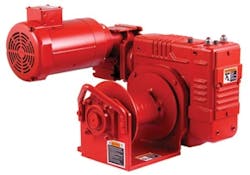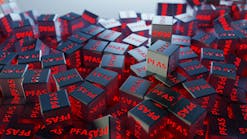By Joe Nye
The discharge of ammonia from wastewater treatment plants (WWTPs) has become a challenging issue throughout the United States. Nearly half of all states – 24 states plus the District of Columbia -- have adopted new rules modifying how ammonia is measured pursuant to the EPA's 1999 water quality criteria, which address total ammonia rather than unionized ammonia and provide more accurate protection for aquatic life.
Biological nitrification is the process of converting ammonia in wastewater to nitrate using aerobic autotrophic bacteria in the treatment process. Nitrification is actually a two-step process for removing ammonia from wastewater using two different types of autotrophic bacteria that oxidize ammonia to nitrite (nitrosomonas) and then oxidize nitrite to nitrate (nitrobacter). Biological nitrification systems are designed to completely convert all ammonia to nitrate.
Both types of autotrophic bacteria require proper biomass concentrations (mixed liquor suspended solids [MLSS]), specific environmental conditions (temperature, pH, alkalinity, etc.), enough residence time in the treatment process, and significantly more air than is required to treat for biochemical oxygen demand (BOD) only. Nitrification requires over four times the amount of oxygen that is required for BOD removal.
Another factor that should be considered in the design of all WWTPs that provide biological nitrification is the loss of alkalinity. Adding alkalinity in the form of sodium hydroxide or other chemicals may be necessary.
Following are some of the most common treatment processes that are used for biological nitrification at wastewater treatment plants (WWTPs).
Conventional Activated Sludge
A conventional activated sludge system is capable of treating many different types of wastewater and is not as difficult to operate as some other treatment processes.
There are several types of conventional activated sludge treatment processes that are suitable to nitrification including complete-mix, plug flow, and step feed treatment. All of these processes have the same basic layout of an aeration basin and secondary clarifier with return and waste activated sludge pumps. The conversion of ammonia occurs in the aeration basins. Since the time required for nitrification is longer than for BOD removal, high-rate and contact stabilization activated sludge treatment processes are not recommended.
Advantages
The conventional activated treatment process is a proven treatment process that is capable of treating many different types of wastewater and is not as complex and difficult to operate as other treatment processes. Conventional activated sludge treatment processes that were designed for BOD removal only can often be modified to provide biological nitrification as well.
Disadvantages
The main disadvantage to constructing conventional activated sludge treatment processes are the higher capital costs associated with these types of WWTPs. Aeration basins and clarifiers are generally constructed with concrete and use expensive mechanical equipment such as blowers, pumps, clarifier mechanisms, etc. Conventional treatment processes are also more susceptible to bulking sludge from filamentous organisms. This often requires the addition of an anoxic step or zone.
Extended Aeration
Extended aeration treatment processes are very similar to conventional activated sludge treatment processes and include aeration basins, clarifiers, return activated sludge, and waste activated sludge processes. The primary difference is the longer hydraulic and solids residence times in the process. The hydraulic residence time is typically around 24 hours and the sludge residence time is over 20 days at design flow rates and organic loadings. Conventional extended aeration and oxidation ditches are typically included in this category. Given enough air, nitrification will occur easily in extended aeration processes.
Advantages
The conversion of ammonia occurs in the aeration basins. Photo shows a diffused aeration system being installed.
Due to the higher hydraulic and solids residence times, extended aeration treatment processes are more forgiving and can provide high quality effluent for different types of wastewater. Extended aeration processes are also even less complex than conventional activated sludge treatment process to operate. With enough oxygen, extended aeration treatment processes can provide very high levels of biological nitrification.
Disadvantages
The primary disadvantage to extended aeration treatment processes is the size of the facilities that are required to provide the longer hydraulic and solids residence times. Therefore, only smaller systems should consider using the extended aeration treatment process. The cost of constructing these types of processes is also more expensive because the aeration basins and clarifiers are generally constructed with concrete and due to the mechanical equipment that is required.
Sequencing Batch Reactor (SBR)
Sequencing batch reactors (SBRs) use the same process as conventional and extended aeration activated sludge treatment process, except that the aeration and clarification processes take place in the same reactor basin. The SBR process has four main steps in the reactor basin: fill, react/aeration, settle, and decant. Wasting usually occurs during the react/aeration step. With enough air, the hydraulic and solids residence times can be manipulated in the reactor basin to promote nitrification.
Advantages
The main advantage to the SBR treatment process is the compact size of the treatment system. By combining the aeration basins and clarifiers into one reactor basin, the footprint required for SBR is less than required for conventional and extended aeration activated sludge treatment processes. There are no RAS pumps or separate clarification equipment necessary. Also, by combining the aeration and clarification steps into one basin, the processes can be manipulated based on the time allotted for each step to provide the desired treated effluent.
Disadvantages
While the ability to manipulate the treatment process by changing the time allotted for each step can be a great benefit, it can also lead to difficulties in operating the treatment plant. Unless the operations personnel are well versed in the operation and maintenance of SBRs, this type of treatment process may not produce the desired treated effluent quality. Most municipal systems also require multiple reactor basins and equalization tanks to allow for peak flows into the WWTP.
Fixed Film
BOD removal and biological nitrification can also be accomplished in fixed film treatment process such as the trickling filter/activated sludge treatment process, rotating biological contactors (RBCs), or moving bed bioreactors (MBBRs). Instead of the microorganisms that treat the wastewater suspended in the liquid, the microorganisms are attached to fixed media and treat the wastewater as it passes through the reactor.
The trickling filter/activated sludge treatment process includes plastic media for the microorganisms to grow on packed inside a tower where wastewater is applied for treatment. The trickling filter is followed by a more conventional activated sludge process. Fans, blowers, clarifiers, RAS, and WAS pumps are required as in the conventional activated sludge treatment process.
RBCs consist of a series of closely packed plastic circular disks that are partially submerged and rotated through the wastewater to be treated. Microorganisms grow on the disks and aeration is achieved as the disks are exposed to the air during rotation. RBCs are followed by clarifiers, RAS, and WAS equipment.
MBBRs include plastic media that is suspended in the wastewater in a separate basin with screens to keep the media in the basin. MBBRs are typically constructed following conventional aeration basins for BOD removal and are designed specifically for biological nitrification only. A twist on the MBBR technology is the integrated fixed film activated sludge (IFAS) treatment process, where the media is suspended in the aeration basin and BOD removal and biological nitrification occur in the same basin.
Advantages
The use of the trickling filters/activated sludge treatment process combines the best qualities of both processes. Trickling filters are more energy efficient and the activated sludge process prevents sloughing material from creating poor effluent quality. These types of systems can also reduce the footprint required by conventional activated sludge treatment processes.
Disadvantages
The primary disadvantages to fixed film treatment technologies are relatively high solids retention time requirements, pumping energy required, sloughing from RBCs, the potential for rotten egg odors, and the potential for snails and filter flies. The MBBR treatment process also requires higher levels of dissolved oxygen. MBBR basins are required to have dissolved oxygen levels up to 7 milligrams per liter (mg/L).
Membrane Bioreactor (MBR)
The membrane bioreactor (MBR) treatment process consists of three main components: 1) anoxic basins, 2) pre-aeration basins, and 3) the MBR basins. Raw wastewater must be screened through a fine screen prior to the anoxic basin. From the anoxic basin, mixed liquor flows into the pre-aeration basins and then into the MBR basins. The membranes are located in the MBR basins where wastewater is passed through the membranes and permeate pumps deliver the effluent to the disinfection process prior to discharge. The membranes remove the need for secondary clarification required in other treatment processes. RAS and WAS pumping is required as in the more conventional treatment processes.
Advantages
The MBR treatment process produces a very high effluent quality without the need for additional clarification or filtration and will not only provide biological nitrification but total nitrogen removal as well. The MBR process can also typically fit into a much smaller area.
Disadvantages
The MBR treatment process tends to be a much more expensive treatment process to construct and there are ongoing costs associated with purchasing replacement membranes. The operation and maintenance costs of the types of systems tend to be higher as well, requiring more power and operator attention.
Lagoon Systems
Although lagoon treatment systems are not typically designed to provide more than BOD and total suspended solids (TSS) removal, biological nitrification can occur given enough hydraulic and solids residence times, the proper environmental conditions (especially temperature), and enough oxygen. Hydraulic residence times must be extended to at least five to seven days (or higher) in the aeration process, higher temperatures must be maintained, and sufficient oxygen must be provided. A mixed liquor recycle system can also be implemented to maintain a high enough biomass to promote the growth of nitrifying bacteria.
Advantages
Lagoon treatment systems have the advantage of being relatively inexpensive to construct and are generally much easier to operate and maintain than mechanical wastewater treatment systems. Since the basins are constructed by excavation or berming of earth, very little concrete is required. Also, expensive mechanical equipment such as pumps and clarifier mechanisms are eliminated.
Disadvantages
It is harder to control the parameters that influence effluent quality such as wastewater temperature, wasting, return rate, and oxygen levels in lagoon treatment systems. Therefore, effluent quality tends to fluctuate more often, which requires more flexibility in the design and operation of these types of facilities. Given the land required for lagoon systems, only small systems should consider the use of this treatment process.
Conclusion
One option is not the best solution for all systems and a good consulting engineer can assist with evaluating all of the options before recommending the best solution for each system. WW
About the Author:
Joe Nye is president and CEO of St. Joseph's Consulting Engineers in Glenwood Springs, CO. He has significant experience in planning, designing, constructing, and operating different types of wastewater treatment systems that provide for biological nitrification.
More WaterWorld Current Issue Articles
More WaterWorld Archives Issue Articles




